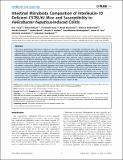Intestinal Microbiota Composition of Interleukin-10 Deficient C57BL/6J Mice and Susceptibility to Helicobacter hepaticus-Induced Colitis
Author(s)
Yang, Ines; Eibach, Daniel; Kops, Friederike; Brenneke, Birgit; Woltemate, Sabrina; Schulze, Jessika; Bleich, André; Gruber, Achim D.; Muthupalani, Sureshkumar; Fox, James G.; Josenhans, Christine; Suerbaum, Sebastian; ... Show more Show less
DownloadYang-2013-Intestinal Microbiot.pdf (1.346Mb)
PUBLISHER_CC
Publisher with Creative Commons License
Creative Commons Attribution
Terms of use
Metadata
Show full item recordAbstract
The mouse pathobiont Helicobacter hepaticus can induce typhlocolitis in interleukin-10-deficient mice, and H. hepaticus infection of immunodeficient mice is widely used as a model to study the role of pathogens and commensal bacteria in the pathogenesis of inflammatory bowel disease. C57BL/6J Il10[superscript −/−] mice kept under specific pathogen-free conditions in two different facilities (MHH and MIT), displayed strong differences with respect to their susceptibilities to H. hepaticus-induced intestinal pathology. Mice at MIT developed robust typhlocolitis after infection with H. hepaticus, while mice at MHH developed no significant pathology after infection with the same H. hepaticus strain. We hypothesized that the intestinal microbiota might be responsible for these differences and therefore performed high resolution analysis of the intestinal microbiota composition in uninfected mice from the two facilities by deep sequencing of partial 16S rRNA amplicons. The microbiota composition differed markedly between mice from both facilities. Significant differences were also detected between two groups of MHH mice born in different years. Of the 119 operational taxonomic units (OTUs) that occurred in at least half the cecum or colon samples of at least one mouse group, 24 were only found in MIT mice, and another 13 OTUs could only be found in MHH samples. While most of the MHH-specific OTUs could only be identified to class or family level, the MIT-specific set contained OTUs identified to genus or species level, including the opportunistic pathogen, Bilophila wadsworthia. The susceptibility to H. hepaticus-induced colitis differed considerably between Il10[superscript −/−] mice originating from the two institutions. This was associated with significant differences in microbiota composition, highlighting the importance of characterizing the intestinal microbiome when studying murine models of IBD.
Date issued
2013-08Department
Massachusetts Institute of Technology. Department of Biological Engineering; Massachusetts Institute of Technology. Division of Comparative MedicineJournal
PLoS ONE
Publisher
Public Library of Science
Citation
Yang, Ines, Daniel Eibach, Friederike Kops, Birgit Brenneke, Sabrina Woltemate, Jessika Schulze, André Bleich, et al. “Intestinal Microbiota Composition of Interleukin-10 Deficient C57BL/6J Mice and Susceptibility to Helicobacter hepaticus-Induced Colitis.” Edited by Markus M. Heimesaat. PLoS ONE 8, no. 8 (August 9, 2013): e70783.
Version: Final published version
ISSN
1932-6203